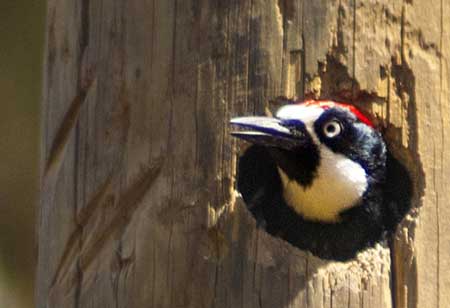|
By John Pint
 For
months I watched the woodpeckers hollow out the telephone pole in front
of my house to build their new home. The problem was that the hole they
were working on was their fourth attempt at nest making and I wondered
just how many holes that pole could take before it snapped.
I wondered if male woodpeckers face the same problems as male weaver
birds (Ploceidae)
which have to “try, try again” until their lady loves say, “Yes, this
is perfect for my nest.” For
months I watched the woodpeckers hollow out the telephone pole in front
of my house to build their new home. The problem was that the hole they
were working on was their fourth attempt at nest making and I wondered
just how many holes that pole could take before it snapped.
I wondered if male woodpeckers face the same problems as male weaver
birds (Ploceidae)
which have to “try, try again” until their lady loves say, “Yes, this
is perfect for my nest.”
Woodpecker homemaking
seems to involve more destruction than construction and I’m amazed
their species is still with us.
The day after the
telephone pole broke in two, Telmex came out and replaced it—with a
brand-new wooden pole identical to the previous one. “Isn’t that
funny,” I said to our sagacious gardener, Don Pancho. “You’d think
they’d put up a concrete pole, wouldn’t you?”
Don Pancho had a very
different take on the matter.
“Bueno, I wouldn‘t think
that, at all. Putting up a concrete pole would be against la Ley de la
Chamba.”
Well chamba is slang for a paying job. “What has chamba to do with it?”
I asked Don Pancho.
“Those carpinteros
(woodpeckers) are providing a big chamba for the Telmex guys who put up
poles. If they installed concrete or metal ones, they’d be out of a job
en un dos
por tres (in nothing flat). Instead, they’ve got
a chamba permanente
just putting up poles here in Pinar de la Venta.”
Well, a light went on in
my head and suddenly a lot of mysterious things I’d noticed in Mexico
no longer seemed so mysterious at all.
Chamba’s Law, I think,
might read as follows: “Fix it so it’ll soon need fixing again.”
I asked Don Pancho if he
could give me another example of Chamba’s Law in action. He pointed at
my feet.
“See
these cobblestones? When they come loose, there are two ways to fix the
problem. One way—which was developed during centuries of trial and
error—results in such an excellent repair job that those cobblestones
will never work their way loose again in your lifetime. The other way
lasts about a year. Both repair jobs look the same to the untrained
eye. If the maintenance men used the first method, they’d have to go
far away from home to find more chamba.”
After hearing this
explanation, I understood why so many streets and roads always seem to
be full of baches (potholes) even though those baches are filled in on
a regular basis. I used to joke that the repair crews filled the
potholes with atole
(watery corn mush) because every time it rains, the
same old baches always reappear as if by magic.
Now I know it’s not
magic, but good old economics, maybe the very same principle impelling
carpinteros
to keep making more holes until they’ve destroyed their
home. Ha ha, and I used to think they
were the birdbrains!
|

